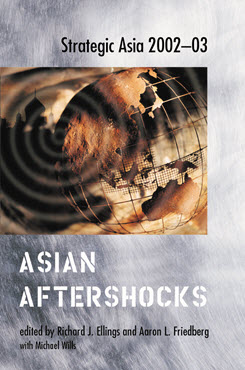South Asia (Strategic Asia 2002-03)
This chapter addresses the major post-September 11 concerns of U.S. policy- making toward South Asia.
On September 11, 2001, the world learned that the United States was terribly vulnerable to a concerted terrorist attack. Two South Asian states, Afghanistan and Pakistan, were close to the heart of the problem. Both showed that terrorist organizations can be found where corrupt ideologies intersect with maldeveloped societies: Afghanistan was a state that had been commandeered by terrorists; Pakistan had the potential to move in the same direction. The terrorists who attacked the United States were trained in and directed from Al Qaeda leaders based in Afghanistan; in turn, Pakistan was supportive of the Afghan regime and cultivated its own home-grown Islamic radicals, many of whom supported Al Qaeda.
This discovery has transformed the world’s understanding of South Asia. Until the attacks of September, most attention had been devoted to India, the region’s rising power. New Delhi was seen by the Clinton and Bush administrations as a possible Asian strategic partner, and Indians, Americans, and others spoke of New Delhi extending its economic, military, and cultural influence throughout the Indian Ocean area and working closely with the United States in keeping regional peace. But September 11 set in motion a complex diplomacy that sorely tested the new Indian-U.S. relationship and revived U.S. ties to Islamabad. It also produced a major India-Pakistan crisis that just might lead to a fundamental transformation of regional politics. This transformation in turn could possibly liberate India from its “Pakistan problem,” enabling it to play a more significant role as a major Asian power, not as a mere regional one.
This chapter addresses the major post-September 11 concerns of U.S. policy- making toward South Asia. First, the chapter summarizes the mixed regional picture that existed on the eve of September 11, when Pakistan seemed to be in decline, India was seen as a rising Asian power, and the tensions between them appeared to be manageable.
Next, the chapter examines the regional consequences of September 11. The most visible was the U.S. military operation in Taliban-controlled Afghanistan, which opened the door for the restoration of a free Afghan state. Another consequence of September 11 was the revival of close U.S.-Pakistan relations, which raises the prospect of a long-term U.S. commitment to helping Pakistan contain its own Muslim radicals and cease its support for such groups in Afghanistan and the Indian-governed portions of the state of Jammu and Kashmir. Defying past experience, the U.S.-Indian strategic relationship was also strengthened, and the United States has good relations with both South Asian powers for the first time in 50 years, raising the question as to whether Washington will use this position to help both states move toward some kind of agreement on Kashmir and other issues.
The chapter then addresses the six-month India-Pakistan crisis of 2001–02. This stand-off was the latest in a series of increasingly frequent and intense India-Pakistan confrontations. Like its predecessors it had the potential to escalate rapidly to a nuclear war, with profound strategic implications for Asia and the United States.
Finally, the chapter examines U.S. choices in this region of “strategic” Asia. Is South Asia a new area of engagement for American diplomacy? If so, will this engagement focus largely on a rising India or will it encompass the still-powerful, but troubled, Pakistan? Washington must weigh the relative importance of a number of interests and devise a policy that balances the new concern with global terrorism with earlier concerns about preventing a nuclear war in South Asia and strategic cooperation with an emerging India.
Strategic Asia
The Strategic Asia annual edited volume incorporates assessments of economic, political, and military trends and focuses on the strategies that drive policy in the region. Learn more about Strategic Asia.


